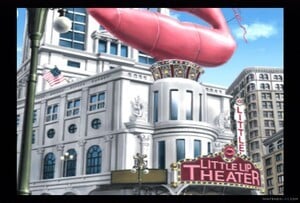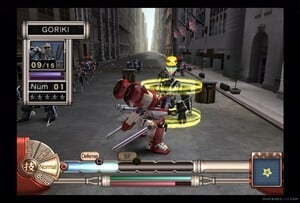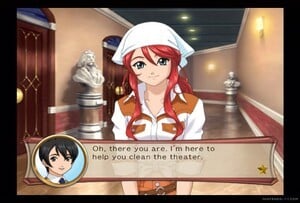
Sakura Wars is a rather interesting series of games and one of Sega's biggest franchises in Japan, though oddly only the spin-off anime has been seen elsewhere – until now. The fifth Sakura Taisen game (as the series is known in Japan), So Long, My Love is the first to get localised for Western markets and as such is a rare treat. We were lucky enough to get some time with a pre-release version of the game as the basis for this preview, so naturally some things may change by the time it's on store shelves.
If you're not familiar with the series the setting is an alternate version of the early 20th century in which major cities are protected from demonic invasion by clandestine forces - known as Flower Division in Tokyo and Paris, and Star Division in New York, where this latest instalment takes place. The cover for these demon fighters is musical review theatre troupes with their bases of operation located beneath the theatres themselves. The principle weapon of these mostly female groups is robot suits powered by a combination of steam and spiritual energy. When not fighting evil in mechas, the troupes put on musicals to combat "the evil in people's souls." The teams are mostly female because young women appear to be more likely to possess the spiritual energy required to drive the mechas in battle. Obviously the whole thing sounds a bit weird, but it's wonderfully over the top and reminds us a great deal of the old Heavy Metal comic strip (and stage production) Starstruck due to the combination of sci-fi, strong female characters and Broadway stage productions. There's a lot of quality anime footage used in the intro movie and in-game cut scenes, though sadly little in the way of original musical numbers with the stage productions mostly being shown but not heard.

The series protagonist in previous games was Ichigo Ogami, who in this game has sent his nephew Shinji Taiga off to New York to join Star Division. Players take on the role of Shinji as he tries to prove himself amongst the Star Division veterans who are uncertain that a 19 year-old rookie fresh from the Imperial Academy has anything to offer them. A large portion of the game is spent building relationships with your fellow team members via RPG segments featuring multiple dialogue choices and outcomes. This is actually a pretty key part of gameplay because stronger relationships with different team members will directly affect the amount of damage your joint attacks do in combat, and given the number of choices available will certainly invite replay.
The conversation sequences take on the guise of a dating sim, which is a game genre that is pretty unique to Japan, so it's unlikely most gamers will have seen anything like it. If you like conversation-heavy RPGs (and pretty anime girls) then these parts will be a lot of fun. These parts are executed using still images with a lot of quality voiceover. In certain parts you're able to look at specific areas using the pointer to move a cursor that will change to a magnifying lens (or other form, depending on the available action) to indicate places to click and make further observations. Of course you'll need to be cautious about this as stroking someone's hair or staring at their, ahem, chest region may not be received too well! Depending on how your chosen statements and actions are received by the other party you'll get a "good" or "bad" sound effect. The characters are all quite different, from the cold and logical Subaru to the sharp-tongued Cheiron and (our personal favourite) the spunky Texan, Gemini. During the RPG sections you'll have access to various parts of New York which are explored in a 3rd person 3D view as you guide "Shiny" (Gemini's pet name for us - er, Shinji) to various places of interest.

Of course it's not all about chatting up the ladies – after all, the defence of New York is in your hands! When danger threatens the team springs into action in a manner that makes it impossible to believe that their base location could possibly be a secret. Jumping into their mechas to confront enemies (also mechas, of course) reminds us a lot of Front Mission Alternative from the PlayStation, though the combat system is a bit different from that in other tactical RPGs we've played. Rather than using a typical grid system and a fixed camera angle, players are presented with a large 3D area featuring a nice zoomed-in look with large mechas (and even bigger bosses) and a freely adjustable camera. Special in this latest series entry is aerial battles which take place after your mech transforms into a plane form, though the gameplay is the same as on the ground. Movement is via  and actions via
and actions via  with a few possibilities beyond unleashing weapons upon your enemies. You have a single gauge which represents the amount of movement, weapons fire and other actions that can be taken and a separate "super" attack metre below. When moving the gauge will dynamically adjust with segments marked so you can see how many "move units" will be left for combat, healing or putting up defencive shields, allowing you to reposition your selected mecha as needed.
with a few possibilities beyond unleashing weapons upon your enemies. You have a single gauge which represents the amount of movement, weapons fire and other actions that can be taken and a separate "super" attack metre below. When moving the gauge will dynamically adjust with segments marked so you can see how many "move units" will be left for combat, healing or putting up defencive shields, allowing you to reposition your selected mecha as needed.
Targeting happens automatically when you're within range of an enemy and if multiple targets are available they can be toggled through via right and left on  . Different actions are selected via up/down on
. Different actions are selected via up/down on  and include normal attack, super attack, joint attack (assuming one of your teammates is also in range of your target) or healing (for repairing yours or an allied mecha). Attacking an enemy is as simple as targeting them and pressing
and include normal attack, super attack, joint attack (assuming one of your teammates is also in range of your target) or healing (for repairing yours or an allied mecha). Attacking an enemy is as simple as targeting them and pressing  . If you have enough units to pull off multiple attacks these can be chained by pressing the button repeatedly up to a maximum of five times. Attacking results in the scene changing so that only the mechs involved are visible with progressively more impressive effects being displayed and some nice OTT dialogue. Of course the super attack is where all the stops are pulled out and consists of some rather lengthy animated sequences of your character making grand pronouncements before carrying out some brilliant, flashy act of destruction. There's further excess on offer before every player character's turn with a camera zoom, a slide-out still image and an audio clip preceding each one. Thoughtfully all of these sequences (and dialogue in the "dating sim" bits) can be skipped through with judicial button presses to save time.
. If you have enough units to pull off multiple attacks these can be chained by pressing the button repeatedly up to a maximum of five times. Attacking results in the scene changing so that only the mechs involved are visible with progressively more impressive effects being displayed and some nice OTT dialogue. Of course the super attack is where all the stops are pulled out and consists of some rather lengthy animated sequences of your character making grand pronouncements before carrying out some brilliant, flashy act of destruction. There's further excess on offer before every player character's turn with a camera zoom, a slide-out still image and an audio clip preceding each one. Thoughtfully all of these sequences (and dialogue in the "dating sim" bits) can be skipped through with judicial button presses to save time.

Whilst the optional tutorials and on-screen prompts all presume use of the Remote and Nunchuk, Classic Controller support is also on offer. We certainly hope the fact that using this alternative doesn't appear to be registered by the game's tutorials and menus is down to the build of the game we're previewing; otherwise players will face having to remember which button presses differ from what's being displayed on screen when using one. Another problem we noted was during RPG sequences requiring controller actions to deal with plot issues like carrying out repairs to the theatre's electrical system. In one case simultaneous rotations both  and
and  were required; the latter of which was just too awkward to perform in the time allotted. It's one instance where motion control would have been preferred, but other than the pointer use indicated previously (and optional rumble), it doesn't appear that any other unique aspects of the Remote are utilised; meaning the Classic Controller may end up being the better control option.
were required; the latter of which was just too awkward to perform in the time allotted. It's one instance where motion control would have been preferred, but other than the pointer use indicated previously (and optional rumble), it doesn't appear that any other unique aspects of the Remote are utilised; meaning the Classic Controller may end up being the better control option.
Without question Sakura Wars is unlike any other gaming franchise around. We certainly feel fortunate to be getting a chance to play it and eagerly anticipate getting our hands on a copy when it hits retail, which will be this month in North America and Europe.

Comments 17
kinda sad that the PS2 version will have japanese and english voice-overs, while the Wii version will only have english. Kinda seems like i already know which one I will be getting.
Bizzare yet strangely appealing
I really like this game. I've never played a dating sim, but I can certainly see the appeal. Whilst it's true this is lacking a Japanese audio track the quality of the English voice-over is really excellent, so I cannot say I feel hard done by - besides it does take place in New York, so it seems fitting everyone is speaking English!
I'm intriqued and hoping that the first western release establishes it successfully outside of Japan, so we can possibly see more.
I predict very poor sales over here.
I want it. It's sad that the pre-order bonus isn't available over Amazon.
Got a creaditable 81% in the latest ONM. Not for me, but interesting.
I rather enjoyed my time with it as well. Could be worth picking up
i can't wait for this game
Isn't the PS2 version cheaper as well?
I mean ffs are publishers morons!?
I'll certainly be renting it, that's for sure. The combat segments look really good, though I personally can't stand dating games.
Me neither, Mickeymac. There's just something sketchy about flirting with a fictional character. The only "dating sim" I enjoyed was the scene in Super Paper Mario where Francis the nerdy chameleon guy spent about 49 seconds flirting with Peach before she pulled out an explosive.
I've always been curious about the Sakura Wars games; i'll probably pick this up unless reviews are really unfavorable.
I'm kind of torn as to whether I want the PS2 version or the Wii version more.
@Oregano: According to Amazon (US) and GameStop, the premium PS2 version is $10 more than the Wii version. The regular PS2 version of the game may be cheaper, but won't have the Japanese language version of the game. It doesn't even look like anyone will be carrying the regular PS2 version, anyway.
I´ll getting the pre order bonus
I find Gemini fairly attractive.
Gemini is the best, but I also really started warming up to Subaru, which surprised me.
Tap here to load 17 comments
Leave A Comment
Hold on there, you need to login to post a comment...